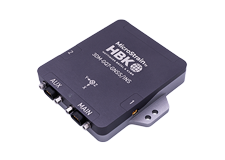

Torque-Link-200
Transform standard driveshafts into wireless torque transducers by application of one strain bridge. The node supports high resolution, low noise data collection from 1 differential input channel at a sample rate up to 1 kHz. An integrated hall effect sensor enables reporting of RPM and total pulses allowing for the derivation of real-time power in torque applications.
Product Highlights
- Two to six inch diameter shaft (standard), more sizes available on request
- One differential input channel (standard) for full-bridge strain gauge integration (two channels optional)
- Ideal for static and dynamic torque measurements with full temperature compensation and bending cancellation
- Alternative gauge configurations enable axial and bending measurements
- Rugged ABS housing designed for remote, long-term installation on cylindrical shafts
- Application-specific designs available on request
High Performance
- Lossless data throughput and synchronized node-to-node sampling of ±50 μS in LXRS+ and LXRS-enabled modes
- Up to 1024 Hz sampling
- Noise as low as 1 µV p-p
- High resolution 24-bit data
- Datalog up to 8 million data points
Ease of Use
- Installs over existing strain elements and shafts with no mechanical modifications
- Configurable housing geometry will accommodate any shaft size
- Wireless data transmission allows installation on rotating components without a slip ring
|
General |
|
|---|---|
|
Sensor input channels |
Differential analog, 1 channel (standard), 2 channels (optional) , 1 RPM/pulse |
|
Integrated sensors |
Internal temperature, 1 channel |
|
Data storage capacity |
16 M Bytes (up to 8,000,000 data points) |
|
Analog Input Channels |
|
|
Selectable measurement ranges |
±19.5 mV to ±2.5 V |
|
Single-ended input impedance |
1 Mohm |
|
Resolution |
24-bit |
|
Digital filter* |
Configurable SINC4 low pass filter for reducing noise |
|
Bridge excitation voltage |
Configurable: 1.5 V or 2.5 V (100 mA) |
|
Measurement gain and offset |
1 to 128 |
|
Integrated Temperature Channel |
|
|
Measurement range |
-40 to 105° C |
|
Accuracy |
±0.25° C |
|
Sampling |
|
|
Sampling modes |
Continuous, periodic burst, or event triggered |
|
Sampling rates |
Up to 1024 Hz |
|
Sample rate stability |
±5 ppm |
|
Network capacity |
Up to 127 nodes per RF channel depending on settings. See: |
|
Synchronization between nodes |
± 50 μsec |
|
Operating Parameters |
|
|
Wireless communication range |
Line of sight: 1 km (ideal), 400 m (typical); Indoor/obstructions: 50 m (typical) |
|
Radio frequency (RF) transceiver carrier |
License-free 2.405 to 2.480 GHz with 16 channels |
|
RF communication protocol |
IEEE 802.15.4 |
|
Power source |
High performance: 1.5 V Lithium AAA (L92) recommended; Lower performance: Alkaline AAA -decreased temperature range and battery life |
|
Power consumption |
Configuration dependent (see user manual) |
|
Operating temperature |
-40°C to +60°C |
|
Angular acceleration limit |
500g sustained, 1000g intermittent |
|
Maximum RPM |
Operating condition dependent (see user manual) |
|
Physical Specifications |
|
|
Dimensions |
See Datasheet table |
|
Environmental rating |
IP 66, tested to DO-160 standards for temperature variation, humidity, and vibration |
|
Enclosure material |
ABS thermoplastic |
|
Integration |
|
|
Compatible gateways |
All WSDA gateways |
|
Software |
SensorCloud™, SensorConnect™, Windows 7, 8 & 10 compatible |
|
Software development kit (SDK) |
|
|
Regulatory compliance |
FCC (U.S.), IC (Canada), CE (European Union), ROHS |
- Condition-based monitoring
- Health monitoring of rotating components, aircraft, structures, and vehicles
- Static and dynamic torque measurements
Contact for pricing and lead time--a minimum order quantity may apply










